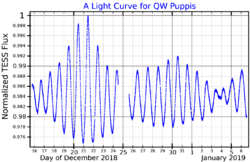Astronomy:QW Puppis
From HandWiki
Short description: F3V star in the constellation Puppis
| Observation data Equinox J2000.0]] (ICRS) | |
|---|---|
| Constellation | Puppis |
| Right ascension | 07h 12m 33.62514s[1] |
| Declination | −46° 45′ 33.4966″[1] |
| Apparent magnitude (V) | 4.49[2] |
| Characteristics | |
| Spectral type | F3V Fe-1.0[3] |
| U−B color index | −0.01[2] |
| B−V color index | +0.32[2] |
| Variable type | γ Dor[4] |
| Astrometry | |
| Radial velocity (Rv) | +0.10[5] km/s |
| Proper motion (μ) | RA: −135.806[1] mas/yr Dec.: +107.433[1] mas/yr |
| Parallax (π) | 46.9031 ± 0.1185[1] mas |
| Distance | 69.5 ± 0.2 ly (21.32 ± 0.05 pc) |
| Absolute magnitude (MV) | 2.84[6] |
| Details | |
| Mass | 1.52[7] M☉ |
| Radius | 1.7[1] R☉ |
| Luminosity | 6.4[7] L☉ |
| Surface gravity (log g) | 4.17[8] cgs |
| Temperature | 6,934[7] K |
| Metallicity [Fe/H] | −0.24[6] dex |
| Rotational velocity (v sin i) | 51[7] km/s |
| Age | 1.6[1] Gyr |
| Other designations | |
| Database references | |
| SIMBAD | data |
QW Puppis (QW Pup) is a class F3V (yellow-white dwarf) star in the constellation Puppis. Its apparent magnitude is 4.49 and it is approximately 69.5 light years away based on parallax.
It is a Gamma Doradus variable, ranging from 4.5 to 4.47 magnitude with a period of 0.96 days.[4] With a mass of 1.5 M☉ and an age of 1.6 billion years, it is about halfway through its main sequence lifetime.[7]
References
- ↑ 1.0 1.1 1.2 1.3 1.4 1.5 1.6 Vallenari, A. et al. (2022). "Gaia Data Release 3. Summary of the content and survey properties". Astronomy & Astrophysics. doi:10.1051/0004-6361/202243940 Gaia DR3 record for this source at VizieR.
- ↑ 2.0 2.1 2.2 Ducati, J. R. (2002). "VizieR Online Data Catalog: Catalogue of Stellar Photometry in Johnson's 11-color system". CDS/ADC Collection of Electronic Catalogues 2237. Bibcode: 2002yCat.2237....0D.
- ↑ Gray, R. O.; Corbally, C. J.; Garrison, R. F.; McFadden, M. T.; Bubar, E. J.; McGahee, C. E.; O'Donoghue, A. A.; Knox, E. R. (2006). "Contributions to the Nearby Stars (NStars) Project: Spectroscopy of Stars Earlier than M0 within 40 pc--The Southern Sample". The Astronomical Journal 132 (1): 161–170. doi:10.1086/504637. Bibcode: 2006AJ....132..161G.
- ↑ 4.0 4.1 Watson, C. L. (2006). "The International Variable Star Index (VSX)". The Society for Astronomical Sciences 25th Annual Symposium on Telescope Science. Held May 23–25 25: 47. Bibcode: 2006SASS...25...47W.
- ↑ Gontcharov, G. A. (2006). "Pulkovo Compilation of Radial Velocities for 35 495 Hipparcos stars in a common system". Astronomy Letters 32 (11): 759–771. doi:10.1134/S1063773706110065. Bibcode: 2006AstL...32..759G.
- ↑ 6.0 6.1 Anderson, E.; Francis, Ch. (2012). "XHIP: An extended hipparcos compilation". Astronomy Letters 38 (5): 331. doi:10.1134/S1063773712050015. Bibcode: 2012AstL...38..331A. Vizier catalog entry
- ↑ 7.0 7.1 7.2 7.3 7.4 Zorec, J.; Royer, F. (2012). "Rotational velocities of A-type stars". Astronomy & Astrophysics 537: A120. doi:10.1051/0004-6361/201117691. Bibcode: 2012A&A...537A.120Z. Vizier catalog entry
- ↑ David, Trevor J.; Hillenbrand, Lynne A. (2015). "The Ages of Early-Type Stars: Strömgren Photometric Methods Calibrated, Validated, Tested, and Applied to Hosts and Prospective Hosts of Directly Imaged Exoplanets". The Astrophysical Journal 804 (2): 146. doi:10.1088/0004-637X/804/2/146. Bibcode: 2015ApJ...804..146D. Vizier catalog entry
- ↑ "MAST: Barbara A. Mikulski Archive for Space Telescopes". Space Telescope Science Institute. https://mast.stsci.edu/portal/Mashup/Clients/Mast/Portal.html.
 |



